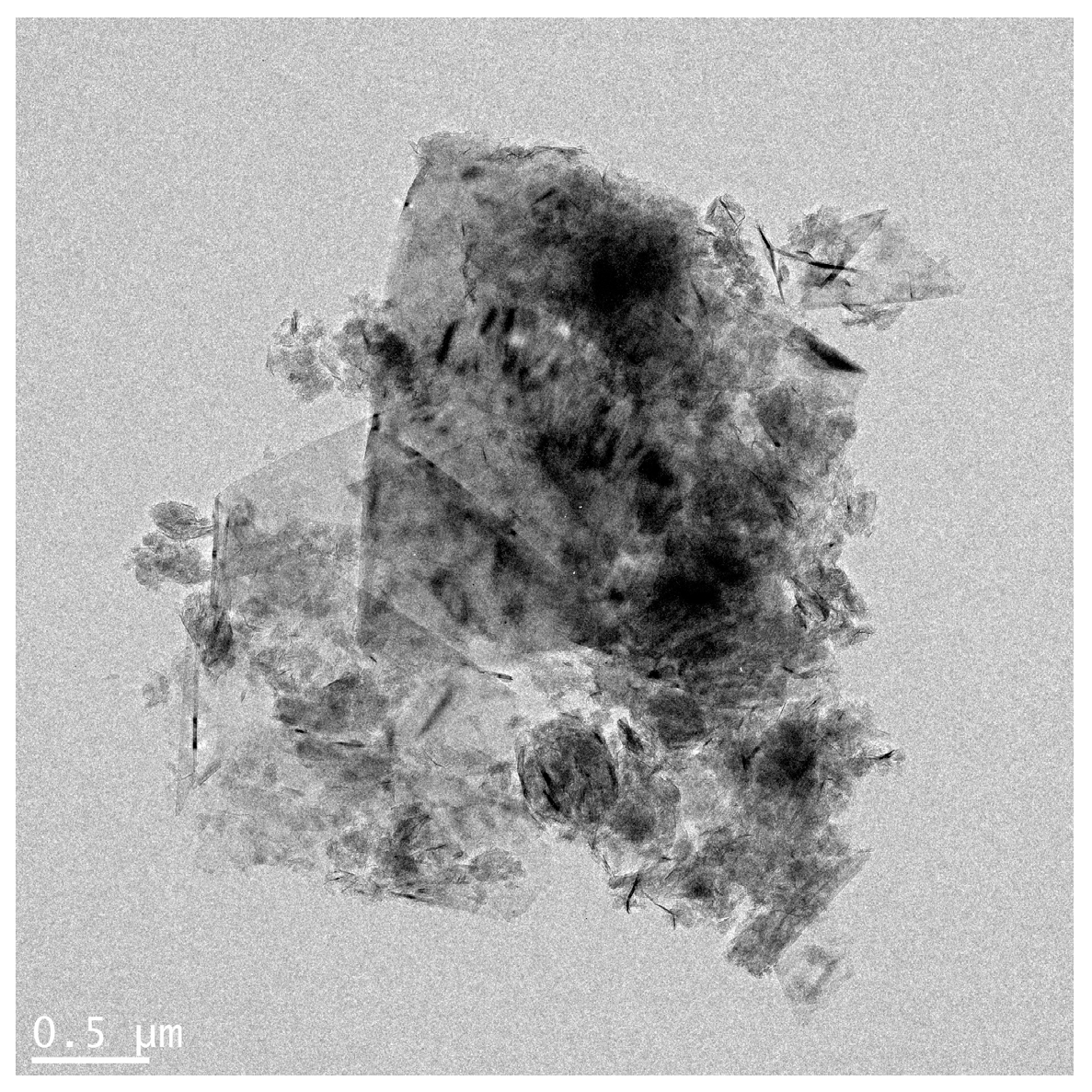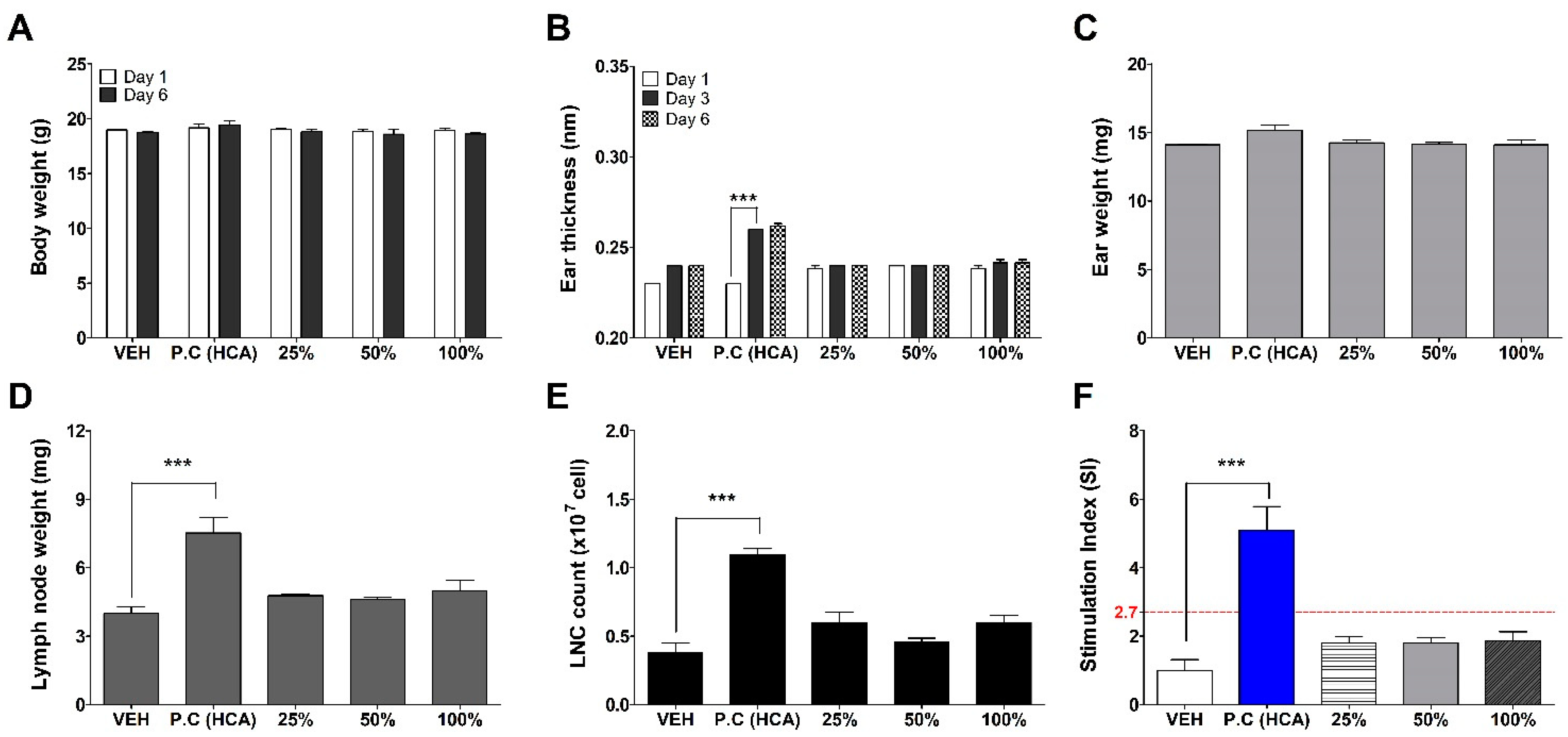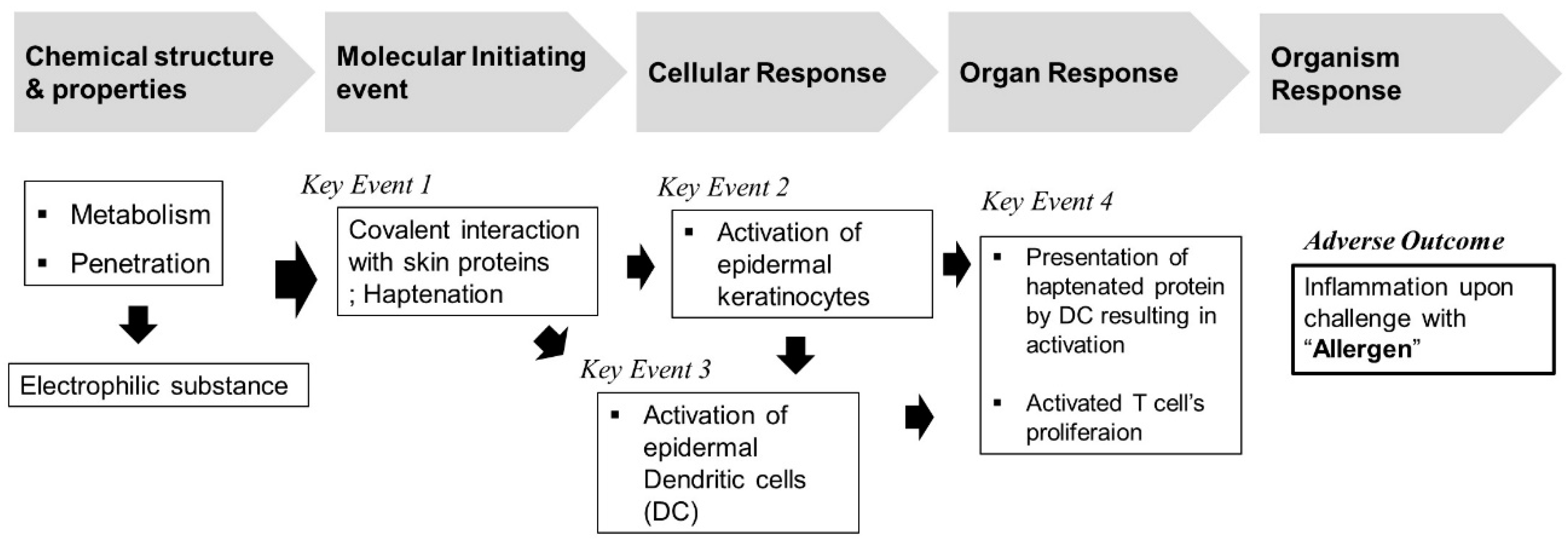Skin Sensitization Evaluation of Carbon-Based Graphene Nanoplatelets
Abstract
1. Introduction
2. Materials and Methods
2.1. Graphene Nanoplatelets
2.2. Preparation of GNP Suspensions
2.3. KeratinoSensTM Cell Culture
2.4. GNP Suspension Treatments and KeratinoSensTM Assay Methods
2.5. Pro-Inflammatory Cytokines Analysis of Supernatant
2.6. Animals
2.7. GNP Treatments and LLNA: BrdU-FCM Assay Methods
2.8. Statistical Analysis
3. Results
3.1. Physicochemical Characteristic of GNPs
3.2. Evaluation of GNPs in the KeratinoSensTM Assay
3.3. Evaluation of Pro-Inflammatory Cytokines in KeratinoSensTM Cells
3.4. Evaluation of GNPs in the LLNA: BrdU-FCM Assay
4. Discussion
5. Conclusions
Author Contributions
Funding
Institutional Review Board Statement
Informed Consent Statement
Data Availability Statement
Conflicts of Interest
References
- Chen, Y.; Zhang, B.; Liu, G.; Zhuang, X.; Kang, E.-T. Graphene and its derivatives: Switching ON and OFF. Chem. Soc. Rev. 2012, 41, 4688–4707. [Google Scholar] [CrossRef]
- Wang, H.; Cui, L.-F.; Yang, Y.; Casalongue, H.S.; Robinson, J.T.; Liang, Y.; Cui, Y.; Dai, H. Mn3O4−Graphene Hybrid as a High-Capacity Anode Material for Lithium Ion Batteries. J. Am. Chem. Soc. 2010, 132, 13978–13980. [Google Scholar] [CrossRef]
- Oberdörster, G.; Oberdörster, E.; Oberdörster, J. Nanotoxicology: An Emerging Discipline Evolving from Studies of Ultrafine Particles. Environ. Health Perspect. 2005, 113, 823–839. [Google Scholar] [CrossRef] [PubMed]
- Maynard, A.D.; Kuempel, E.D. Airborne Nanostructured Particles and Occupational Health. J. Nanoparticle Res. 2005, 7, 587–614. [Google Scholar] [CrossRef]
- Dréno, B.; Alexis, A.; Chuberre, B.; Marinovich, M. Safety of titanium dioxide nanoparticles in cosmetics. J. Eur. Acad. Dermatol. Venereol. 2019, 33, 34–46. [Google Scholar] [CrossRef] [PubMed]
- Rusche, B. The 3Rs and animal welfare–Conflict or the way forward? ALTEX 2003, 20, 63–76. [Google Scholar] [PubMed]
- Kaluzhny, Y.; Kandárová, H.; Hayden, P.; Kubilus, J.; D’Argembeau-Thornton, L.; Klausner, M. Development of the EpiOcular™ Eye Irritation Test for Hazard Identification and Labelling of Eye Irritating Chemicals in Response to the Requirements of the EU Cosmetics Directive and REACH Legislation. Altern. Lab. Anim. 2011, 39, 339–364. [Google Scholar] [CrossRef]
- OECD. The Adverse Outcome Pathway for Skin Sensitisation Initiated by Covalent Binding to Proteins; OECD Series on Testing and Assessment, No. 168; OECD Publishing: Paris, France, 2014. [Google Scholar] [CrossRef]
- OECD. Test No. 442C: In Chemico Skin Sensitization: Assays Addressing the Adverse Outcome Pathway Key Event on Covalent Binding to Proteins, OECD Guidelines for the Testing of Chemicals Section 4. 2020. Available online: https://www.oecd-ilibrary.org/environment/test-no-442c-in-chemico-skin-sensitisation_9789264229709-en (accessed on 26 June 2020).
- OECD. Test No. 442D: In Vitro Skin Sensitisation: ARE-Nrf2 Luciferase Test Method. Organisation for Economic Co-Operation and Development (OECD), Paris 10. 2018. Available online: https://www.oecd-ilibrary.org/environment/test-no-442d-invitro-skin-sensitisation_9789264229822-en (accessed on 25 June 2018).
- OECD. Test No 442E: In Vitro Skin Sensitisation: In Vitro Skin Sensitisation Assays Addressing the Key Event on Ac-Tivation of Dendritic Cells on the Adverse Outcome Pathway for Skin Sensitisation. OECD Guidelines for the Testing of Chemicals, Section 4: 21. 2018. Available online: https://www.oecd-ilibrary.org/environment/test-no-442e-in-vitro-skin-sensitisation_9789264264359-en (accessed on 25 June 2018).
- OECD. Test No. 442B: Skin Sensitization: Local Lymph Node Assay: BrdU-Elisa or-Fcm. OECD Guidelines for the Testing of Chemicals, Section 4. 2018. Available online: https://www.oecd-ilibrary.org/environment/test-no-442bskin-sensitization_9789264090996-en (accessed on 25 June 2018).
- Park, Y.-H.; Jeong, S.H.; Yi, S.M.; Choi, B.H.; Kim, Y.; Kim, I.; Kim, M.-K.; Son, S.W. Analysis for the potential of polystyrene and TiO2 nanoparticles to induce skin irritation, phototoxicity, and sensitization. Toxicol. In Vitr. 2011, 25, 1863–1869. [Google Scholar] [CrossRef]
- Yoshioka, Y.; Kuroda, E.; Hirai, T.; Tsutsumi, Y.; Ishii, K.J. Allergic Responses Induced by the Immunomodulatory Effects of Nanomaterials upon Skin Exposure. Front. Immunol. 2017, 8, 169. [Google Scholar] [CrossRef]
- Kim, S.; Lee, D.H.; Lee, J.H.; Yang, J.-Y.; Shin, H.-S.; Lee, J.; Jung, K.; Jeong, J.; Oh, J.-H.; Lee, J.K. Evaluation of the Skin Sensitization Potential of Carbon Nanotubes Using Alternative In Vitro and In Vivo Assays. Toxics 2020, 8, 122. [Google Scholar] [CrossRef]
- Jung, K.-M.; Bae, I.-H.; Kim, B.-H.; Kim, W.-K.; Chung, J.-H.; Park, Y.; Lim, K.-M. Comparison of flow cytometry and immunohistochemistry in non-radioisotopic murine lymph node assay using bromodeoxyuridine. Toxicol. Lett. 2010, 192, 229–237. [Google Scholar] [CrossRef]
- Ahn, I.; Kim, T.-S.; Jung, E.-S.; Yi, J.-S.; Jang, W.-H.; Jung, K.; Park, M.; Jung, M.-S.; Jeon, E.-Y.; Yeo, K.-U.; et al. Performance standard-based validation study for local lymph node assay: 5-bromo-2-deoxyuridine-flow cytometry method. Regul. Toxicol. Pharmacol. 2016, 80, 183–194. [Google Scholar] [CrossRef] [PubMed]
- Brownson, D.A.C.; Banks, C.E. Graphene electrochemistry: An overview of potential applications. Analyst 2010, 135, 2768–2778. [Google Scholar] [CrossRef]
- Zhang, Y.; Nayak, T.R.; Hong, H.; Cai, W. Graphene: A versatile nanoplatform for biomedical applications. Nanoscale 2012, 4, 3833–3842. [Google Scholar] [CrossRef]
- Nasirzadeh, N.; Azari, M.R.; Rasoulzadeh, Y.; Mohammadian, Y. An assessment of the cytotoxic effects of graphene nanoparticles on the epithelial cells of the human lung. Toxicol. Ind. Health 2019, 35, 79–87. [Google Scholar] [CrossRef]
- Dobrovolskaia, M.A.; McNeil, S.E. Immunological properties of engineered nanomaterials. Nat. Nanotechnol. 2007, 2, 469–478. [Google Scholar] [CrossRef] [PubMed]
- Cho, W.-S.; Duffin, R.; Bradley, M.; Megson, I.L.; MacNee, W.; Howie, S.E.; Donaldson, K. NiO and Co3O4 nanoparticles induce lung DTH-like responses and alveolar lipoproteinosis. Eur. Respir. J. 2011, 39, 546–557. [Google Scholar] [CrossRef] [PubMed]
- Natsch, A.; Ryan, C.A.; Foertsch, L.; Emter, R.; Jaworska, J.; Gerberick, F.; Kern, P. A dataset on 145 chemicals tested in alternative assays for skin sensitization undergoing prevalidation. J. Appl. Toxicol. 2013, 33, 1337–1352. [Google Scholar] [CrossRef]
- EURL-ECVAM. Recommendation on the KeratinoSens™ Assay for Skin Sensitisation Testing; JRC Scientific and Policy Reports. Publication Office of the European Union: Luxembourg, Germany, 2014. Available online: https://ec.europa.eu/jrc/en/publication/eur-scientific-and-technical-research-reports/eurlecvam-recommendation-keratinosenstm-assay-skin-sensitisation-testing (accessed on 22 October 2020).
- Andres, E.; Sá-Rocha, V.M.; Barrichello, C.; Haupt, T.; Ellis, G.; Natsch, A. The sensitivity of the KeratinoSens™ assay to evaluate plant extracts: A pilot study. Toxicol. In Vitro 2013, 27, 1220–1225. [Google Scholar] [CrossRef]
- Settivari, R.S.; Gehen, S.C.; Amado, R.A.; Visconti, N.R.; Boverhof, D.R.; Carney, E.W. Application of the KeratinoSens™ assay for assessing the skin sensitization potential of agrochemical active ingredients and formulations. Regul. Toxicol. Pharmacol. 2015, 72, 350–360. [Google Scholar] [CrossRef]
- Bihari, P.; Vippola, M.; Schultes, S.; Praetner, M.; Khandoga, A.G.; A Reichel, C.; Coester, C.; Tuomi, T.; Rehberg, M.; Krombach, F. Optimized dispersion of nanoparticles for biological in vitro and in vivo studies. Part. Fibre Toxicol. 2008, 5, 14. [Google Scholar] [CrossRef] [PubMed]
- Cho, W.-S.; Thielbeer, F.; Duffin, R.; Johansson, E.M.V.; Megson, I.L.; MacNee, W.; Bradley, M.; Donaldson, K. Surface functionalization affects the zeta potential, coronal stability and membranolytic activity of polymeric nanoparticles. Nanotoxicology 2013, 8, 202–211. [Google Scholar] [CrossRef] [PubMed]
- Lee, S.; Hwang, S.-H.; Jeong, J.; Han, Y.; Kim, S.-H.; Lee, D.; Lee, H.-S.; Chung, S.-T.; Jeong, J.; Roh, C.; et al. Nickel oxide nanoparticles can recruit eosinophils in the lungs of rats by the direct release of intracellular eotaxin. Part. Fibre Toxicol. 2015, 13, 30. [Google Scholar] [CrossRef] [PubMed]
- Coquette, A.; Berna, N.; VandenBosch, A.; Rosdy, M.; De Wever, B.; Poumay, Y. Analysis of interleukin-1α (IL-1α) and interleukin-8 (IL-8) expression and release in in vitro reconstructed human epidermis for the prediction of in vivo skin irritation and/or sensitization. Toxicol. In Vitr. 2003, 17, 311–321. [Google Scholar] [CrossRef]
- Bezerra, S.F.; Rodrigues, B.D.S.; Da Silva, A.C.G.; De Ávila, R.I.; Brito, H.R.G.; Cintra, E.R.; Veloso, D.F.M.C.; Lima, E.M.; Valadares, M.C. Application of the adverse outcome pathway framework for investigating skin sensitization potential of nanomaterials using new approach methods. Contact Dermat. 2021, 84, 67–74. [Google Scholar] [CrossRef]
- Van de Veerdonk, F.L.; Netea, M.G.; Dinarello, C.A.; Joosten, L.A. Inflammasome activation and IL-1β and IL-18 processing during infection. Trends Immunol. 2011, 32, 110–116. [Google Scholar] [CrossRef]
- OECD. Multiwalled Carbon Nanotubes (MWCNT): Summary of the Dossier, Series on the Safety of Manufactured Nanomaterials No. 68. 2016. Available online: http://www.oecd.org/officialdocuments/publicdisplaydocumentpdf/?cote=env/jm/mono(2016b)20&doclanguage=en (accessed on 30 May 2016).
- OECD. Single Walled Carbon Nanotubes (SWCNTs): Summary of the Dossier, Series on the Safety of Manufactured Nanomaterials No. 70. 2016. Available online: http://www.oecd.org/officialdocuments/publicdisplaydocumentpdf/?cote=env/jm/mono(2016a)22&doclanguage=en (accessed on 7 July 2016).





| GNPs | In KeratinoSensTM | In Local Lymph Node Assay (LLNA): BrdU-FCM |
|---|---|---|
| Diameter | <2 microns, and a thickness of a few nanometers | |
| Surface area (m2/g) | 300 | |
| Zeta potential (mV) | ||
| in DW | −23.32 ± 0.80 | −23.32 ± 0.80 |
| in working solution * | −27.17 ± 0.94 | −24.60 ± 0.26 |
| Molecular weight (g/mol) | 12.01 | |
| Carbon content (%) | >98 | |
| Endotoxin (EU/mL) | <0.1 (all samples) | |
| Proficiency Substances | CAS RN | Physical Form | In Vivo Prediction | Reference Range * | KeratinoSensTM Assay | |||
|---|---|---|---|---|---|---|---|---|
| EC1.5 (µM) | IC50 (µM) | EC1.5 (µM) | IC50 (µM) | Results | ||||
| Isopropanol | 67-63-0 | Liquid | Non-sensitizer | >1000 | >1000 | >1000 | >1000 | Negative |
| Salicylic acid | 69-72-7 | solid | Non-sensitizer | >1000 | >1000 | >1000 | >1000 | Negative |
| Lactic acid | 50-21-5 | Liquid | Non-sensitizer | >1000 | >1000 | >1000 | >1000 | Negative |
| Glycerol | 56-81-5 | Liquid | Non-sensitizer | >1000 | >1000 | >1000 | >1000 | Negative |
| Cinnamyl alcohol | 104-54-1 | solid | Week-sensitizer | 25–175 | >1000 | 36.5 | >1000 | Positive |
| Ethylene glycol dimethacrylate | 97-90-5 | Liquid | Week-sensitizer | 5–125 | >500 | 77.2 | 795.6 | Positive |
| 2-Mercapto benzothiazole | 149-30-4 | solid | Moderate-sensitizer | 25–250 | >500 | 129.4 | 573.4 | Positive |
| Methyldibromo glutaronitrile | 35691-65-7 | solid | Strong-sensitizer | <20 | 20–100 | 1.9 | 42.7 | Positive |
| 4-Methylamino phenol sulfate | 55-55-0 | solid | Strong-sensitizer | <12.5 | 20–200 | 7.9 | 48.3 | Positive |
| 2,4-Dinitro-chlorobenzene | 97-00-7 | solid | Extreme-sensitizer | <12.5 | 5–20 | 2.6 | 12.4 | Positive |
| NMs | CAS RN | Physical Form | KeratinoSensTM Assay Results | ||||
|---|---|---|---|---|---|---|---|
| Imax | EC1.5 (µM) | Viability (%) * | IC50 (µM) | Classification | |||
| GNPs | 7782-42-5 | Solid | 1.27 | >2000 | >85 | >2000 | Negative |
Publisher’s Note: MDPI stays neutral with regard to jurisdictional claims in published maps and institutional affiliations. |
© 2021 by the authors. Licensee MDPI, Basel, Switzerland. This article is an open access article distributed under the terms and conditions of the Creative Commons Attribution (CC BY) license (http://creativecommons.org/licenses/by/4.0/).
Share and Cite
Kim, S.-H.; Hong, S.-H.; Lee, J.H.; Lee, D.H.; Jung, K.; Yang, J.-Y.; Shin, H.-S.; Lee, J.; Jeong, J.; Oh, J.-H. Skin Sensitization Evaluation of Carbon-Based Graphene Nanoplatelets. Toxics 2021, 9, 62. https://doi.org/10.3390/toxics9030062
Kim S-H, Hong S-H, Lee JH, Lee DH, Jung K, Yang J-Y, Shin H-S, Lee J, Jeong J, Oh J-H. Skin Sensitization Evaluation of Carbon-Based Graphene Nanoplatelets. Toxics. 2021; 9(3):62. https://doi.org/10.3390/toxics9030062
Chicago/Turabian StyleKim, Sung-Hyun, So-Hye Hong, Jin Hee Lee, Dong Han Lee, Kikyung Jung, Jun-Young Yang, Hyo-Sook Shin, JeongPyo Lee, Jayoung Jeong, and Jae-Ho Oh. 2021. "Skin Sensitization Evaluation of Carbon-Based Graphene Nanoplatelets" Toxics 9, no. 3: 62. https://doi.org/10.3390/toxics9030062
APA StyleKim, S.-H., Hong, S.-H., Lee, J. H., Lee, D. H., Jung, K., Yang, J.-Y., Shin, H.-S., Lee, J., Jeong, J., & Oh, J.-H. (2021). Skin Sensitization Evaluation of Carbon-Based Graphene Nanoplatelets. Toxics, 9(3), 62. https://doi.org/10.3390/toxics9030062






